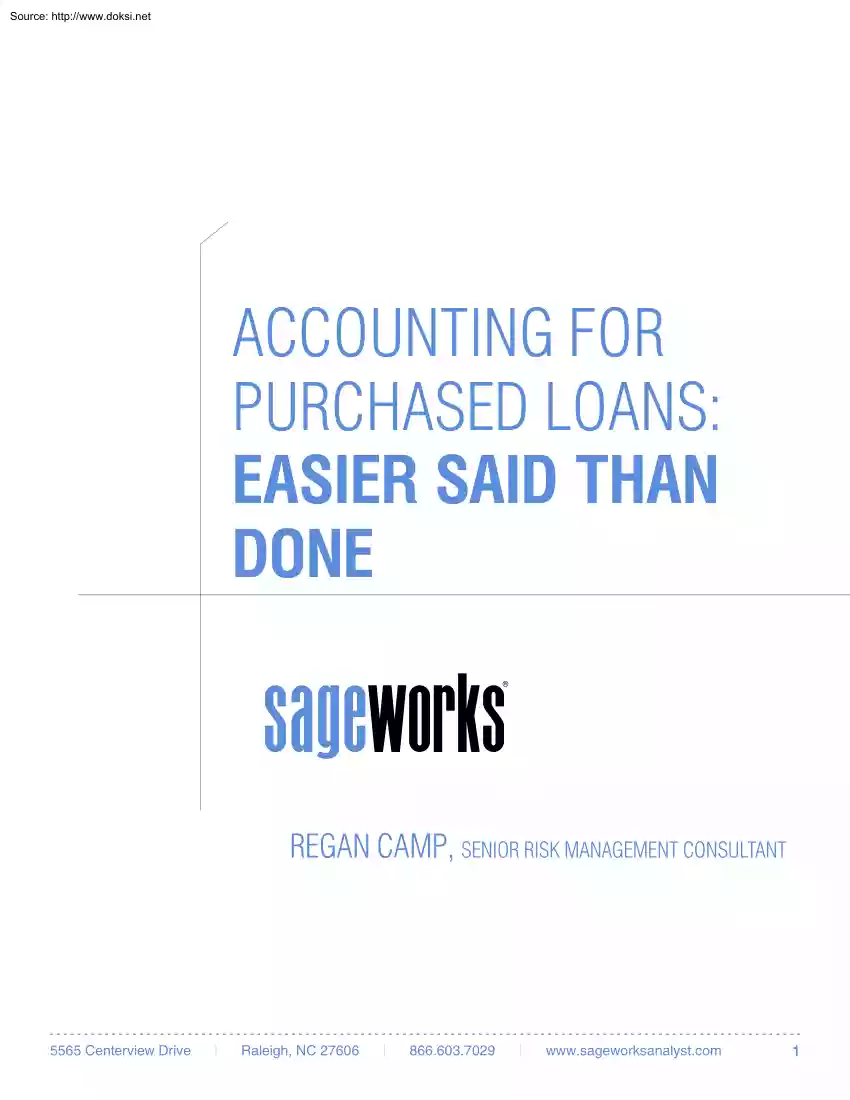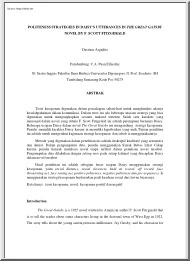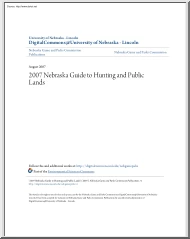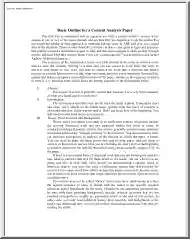Please log in to read this in our online viewer!

Please log in to read this in our online viewer!
No comments yet. You can be the first!
What did others read after this?
Content extract
Source: http://www.doksinet ACCOUNTING FOR PURCHASED LOANS: EASIER SAID THAN DONE REGAN CAMP, SENIOR RISK MANAGEMENT CONSULTANT 5565 Centerview Drive | Raleigh, NC 27606 | 866.6037029 | www.sageworksanalystcom 1 Source: http://www.doksinet TABLE OF CONTENTS Executive Summary- - - - - - - - - - - - - - - - - - - - - - - - - - - - - - - - - - - - - - - 3 Introduction- - - - - - - - - - - - - - - - - - - - - - - - - - - - - - - - - - - - - - - - - - - - - - 4 Easier Said than Done - - - - - - - - - - - - - - - - - - - - - - - - - - - - - - - - - - - - 5 Fair Value Accounting - - - - - - - - - - - - - - - - - - - - - - - - - - - - - - - - - - - - 6 Determining the Appropriate Standard- - - - - - - - - - - - - - - - - - - - 7 ASC 310-20 (FAS 91) - - - - - - - - - - - - - - - - - - - - - -
- - - - - - - - - - - - - - - 8 ASC 310-30 (SOP 03-3)- - - - - - - - - - - - - - - - - - - - - - - - - - - - - - - - - - - 9 Conclusion - - - - - - - - - - - - - - - - - - - - - - - - - - - - - - - - - - - - - - - - - - - - - - 13 About Sageworks & the Author - - - - - - - - - - - - - - - - - - - - - - - - - - 14 Additional Resources - - - - - - - - - - - - - - - - - - - - - - - - - - - - - - - - - - - - 15 5565 Centerview Drive | Raleigh, NC 27606 | 866.6037029 | www.sageworksanalystcom 2 Source: http://www.doksinet EXECUTIVE SUMMARY A n institution’s allowance for loan and lease losses (ALLL) is a significant figure in terms of impact on earnings and capital, and the reserve calculation can be complex, demanding significant time from senior management. When an institution acquires another institution or portfolio,
accounting for the purchased loans introduces additional complexities for the reserve. ASC 310-20 (FAS 91) and ASC 310-30 (SOP 03-3) are the standards for determining losses for nonimpaired and impaired purchased loans, respectively. The premise of these standards as released by the FASB is the purchasing institution’s allowance should only reflect losses incurred after the acquisition and not losses incurred by the selling institution. 5565 Centerview Drive | Raleigh, NC 27606 | 866.6037029 | www.sageworksanalystcom 3 Source: http://www.doksinet INTRODUCTION Traditional wisdom suggests the key ingredients of success in growing a loan portfolio, extending an institution’s footprint or expanding a customer base include good, old-fashioned customer service, hard work and plenty of marketing. Such practices, when properly and abundantly employed, undoubtedly have and always will serve as catalysts to “organic growth” – growth that is critical to the longevity of a
sound institution. ADDITIONAL RESOURCE: However, in light of record-high at-risk bank figures, increasing regulatory pressures, a low-interest-rate environment and the continued struggle for The (ALLL) calculation is one of the most complex and important processes in a financial institution. While there are many resources available to help with the reserve, Sageworks compiled all the necessary content to create “The Complete Guide to the ALLL.” capital, many institutions have and are continuing to seek increased growth via mergers and acquisitions. The acquisition of loan portfolios, particularly those of failed institutions or institutions succumbing to the aforementioned pressures can present healthier institutions with a unique opportunity to rapidly expand their current footprint, enhance their deposit base and provide value to shareholders, oftentimes at significant discounts. Download the e-Book Though these acquisitions can undoubtedly be attractive, what may be less
attractive are the associated GAAP purchase accounting standards, in all their complexities. Such complexities make accounting for purchased loans “easier said than done.” However, those institutions that strive to understand the accounting complexities and prepare themselves to properly comply will be in a great position to reap the benefits offered through acquisition opportunities. To this end, an overview of the more common purchase accounting standards follows. 5565 Centerview Drive | Raleigh, NC 27606 | 866.6037029 | www.sageworksanalystcom 4 Source: http://www.doksinet EASIER SAID THAN DONE Many institutions that have taken advantage of the acquisition opportunities have approached these transactions having underestimated the inherent complexities of prevailing purchase accounting standards – guidance and principles that are ever-changing and require close and constant monitoring in order to ensure appropriate compliance. Because of these complexities, the
creation, implementation and ongoing management of the policies and procedures relating to this unique accounting has proven easier said than done. In fact, this underestimation has required many institutions to rely on third party firms and/or software to help shoulder or completely remove the burden of this complex accounting. Banks may lack both the time and specialization necessary for the accounting standards though many of the principles are similar in nature to the principles for the ALLL of originated loans. 5565 Centerview Drive | Raleigh, NC 27606 | 866.6037029 | www.sageworksanalystcom 5 Source: http://www.doksinet FAIR VALUE ACCOUNTING WEBINAR: When we speak of GAAP purchase accounting, it is often related to “fair Here more about the main challenges in accounting for purchased portfolios: value accounting.” This is due to the fact that all acquired loans are initially Accounting for Consequently, this also means that any associated ALLL is no longer
carried Purchased Loans over to the acquirer’s balance sheet with the loans, as in the past, since the measured at their fair value, which includes estimation of life-of-loan credit loss. fair value of such loans already, presumably, takes into account any applicable discounts for credit quality. For “Day Two” accounting (accounting for the loans after the financial close date of the business combination), we look to two prevailing standards: ASC 310-20 (FAS 91) and ASC 310-30 (SOP 03-3). 5565 Centerview Drive | Raleigh, NC 27606 | 866.6037029 | www.sageworksanalystcom 6 Source: http://www.doksinet DETERMINING THE APPROPRIATE STANDARD In general, acquired loans can be categorized and accounted for under one of two prevailing standards: ASC 310-20 (FAS 91) Nonrefundable Fees and Other Costs or ASC 310-30 (SOP 03-3) Loans and Debt Securities Acquired with Deteriorated Credit Quality. The standard under which each loan must be accounted is determined on a loan-by-loan
basis at acquisition, with the transitioning between standards subsequent to the acquisition date prohibited. When making the determination, the question an institution asks is: “Should this loan be accounted for based on its contractual or expected cash flows? ASC 310-30 uses the acquirer’s “cash flow expected at acquisition” as the benchmarking for calculating the yield (interest income) on the investment in the loan, as well as for purposes of determining whether the loan is impaired and how that impairment should be measured. ASC 310-20 measures yield and impairment utilizing contractual cash flows as benchmarks. Each of these standards has specific and somewhat complex accounting requirements. 5565 Centerview Drive | Raleigh, NC 27606 | 866.6037029 | www.sageworksanalystcom 7 Source: http://www.doksinet ASC 310-20 (FAS 91) If all contractually obligated principal and interest cash flows are expected to be received on an acquired loan, that loan should be
accounted for in accordance with ASC 310-20 (FAS 91), generally considered to be the more basic standard. These are loans that are not considered “credit impaired” at the time of purchase. TACKLING THE CALCULATION For these loans, the purchase discount or premium will generally be accreted (amortized) into income on a level yield over the expected life of the loan. Sageworks Accounting for Purchased Loans is Consider the following illustration: a solution designed to help banks streamline SOP 03-3 and FAS 91 accounting and bring the calculation in-house at the bank. Since this method assumes all contractual cash flows will be collected, for income recognition purposes, should any credit losses be incurred on these loans subsequent to acquisition, a provision to the ALLL would be required, as there is no “carry over” of the ALLL recorded under this standard at acquisition. 5565 Centerview Drive | Raleigh, NC 27606 | 866.6037029 | www.sageworksanalystcom 8 Source:
http://www.doksinet ASC 310-30 (SOP 03-3) In contrast to the former standard, which utilizes contractual cash flows, ASC 310-30 (SOP 03-3) utilizes the acquirer’s expected cash flows as the benchmark for calculating the yield (interest income) on the investment in the loan. These are loans that are considered “credit impaired” at the time of purchase. Acquired loans that meet BOTH of the following criteria must be accounted for in accordance with ASC 310-30 (SOP 03-3): 1. The deterioration in credit quality occurred after origination, and 2. It is probable that the acquirer will be unable to collect all contractually obligated payments from the borrower. The accounting required under the ASC 310-30 standard has additional complexities beyond those requirements of ASC 310-20. One of those primary complexities is the additional required calculation of Accretable Yield vs. NonAccretable Difference As with all acquired loans, a loan accounted for under FAS ASC 310-30 is initially
recorded at its purchase price (fair value). The amount of expected cash flows that exceed the initial investment in the loan represent the “Accretable Yield,” which is recognized as interest income on a level yield basis over the life of the loan. The excess of total contractual cash flows over the cash flows expected to be received at origination is deemed the “Non-Accretable Difference”. 5565 Centerview Drive | Raleigh, NC 27606 | 866.6037029 | www.sageworksanalystcom 9 Source: http://www.doksinet ASC 310-30 (SOP 03-3) (CONT.) Consider the following illustration: This determination of the Accretable vs. Non-Accretable difference is not a onetime conclusion Rather, those loans subject to ASC 310-30 accounting must be reviewed periodically to account for the difference between actual cash flows and those previously forecasted. The remaining cash flows must also be re-forecast If expected cash flows improve, the positive impact is recognized over the life of the
loan through an increase in the accretion rate. The following illustration demonstrates an improvement in cash flow expectations: 5565 Centerview Drive | Raleigh, NC 27606 | 866.6037029 | www.sageworksanalystcom 10 Source: http://www.doksinet ASC 310-30 (SOP 03-3) (CONT.) The financial impact of the reclassification from Non-Accretable Difference to Accretable Yield demonstrated in the illustration above is recognized prospectively through an increase in the accretion rate. It should be noted that ASC 310-30 does give institutions the option to pool together loans of common risk characteristics, defined as loans with (1) similar credit risk (e.g, past due status, FICO score, etc) or risk ratings, and (2) one or more prominent risk characteristics (e.g, collateral type, geographical, industry, etc.) 5565 Centerview Drive | Raleigh, NC 27606 | 866.6037029 | www.sageworksanalystcom 11 Source: http://www.doksinet ASC 310-30 (SOP 03-3) (CONT.) Regardless which metrics
are used, the acquiring institution must document those selections and substantiate why they are appropriate for the population of acquired loans. In addition, these pooled loans must have been acquired together, or within the same fiscal quarter. Then the pool can be treated as a single asset in the application of the accounting standard. Another noteworthy item: in the event that the timing and amount of future cash flows cannot be reasonably projected, then ASC 310-30 allows for the loan to be placed on nonaccrual, at which time the loan can be accounted for under the cost-recovery method or another reasonable accounting method. Under the costrecovery methodology, no accretion income is recognized, and income is only recognized after the carrying amount of the loan has been recovered. Again, as in ASC 310-20,since no ALLL is carried over in purchase accounting, since the fair value of such loans includes any applicable discounts for credit quality, additional allowance provision may
be needed if expected cash flows decline in the future. For many institutions, the complexities of the accounting required for ASC 310-30 loans extend beyond core accounting systems’ capabilities. In such cases, institutions may choose to supplement their existing core system with internallydeveloped or third-party software capable of handling such complexities, or they hire an external firm to perform these calculations. 5565 Centerview Drive | Raleigh, NC 27606 | 866.6037029 | www.sageworksanalystcom 12 Source: http://www.doksinet CONCLUSION Over the past several years, an increasing number of lending institutions have and are continuing to look to acquire/purchase existing loan portfolios, especially those of failed or struggling institutions, as a means by which they might accelerate growth and profitability. Accounting for those acquired loans, however, can be quite complex and cumbersome. Consequently, these same institutions would be prudent to consider both
internal and external resources that may be available to help understand the complexities and also alleviate this burden. 5565 Centerview Drive | Raleigh, NC 27606 | 866.6037029 | www.sageworksanalystcom 13 Source: http://www.doksinet ABOUT SAGEWORKS & THE AUTHOR Sageworks (www.sageworkscom) is a financial information company working with financial institutions, accountants and private-company executives across North America to collect and interpret financial information. Thousands of bankers rely on Sageworks’ credit risk management solutions to streamline credit analysis, risk rating, portfolio stress testing, loan administration and ALLL calculation. Sageworks is also an industry thought leader, regularly publishing whitepapers and hosting webinars on topics important to bankers. Sageworks ALLL is the premiere ALLL automated solution for estimating a financial institution’s reserve. It helps bankers automate their ALLL process and increase consistency in their
methodology, making it defensible to auditors and examiners. Sageworks Accounting for Purchased Loans is a supplement to the reserve solution and empowers bankers to bring the accounting process for acquired loans in-house, increasing transparency with the calculation and improving the institution’s ability to forecast. To find out more, visit www.sageworksanalystcom Regan Camp is a senior risk management consultant at Sageworks, where he serves as a specialist in assisting financial institutions with accurately interpreting and applying federal accounting guidance. Regan primarily focuses on allowance for loan and lease loss provisions (ALLL) and stress testing loan portfolios. Prior to joining Sageworks, he served in various consulting capacities at Deloitte & Touche, L.P and Dittrich & Associates LLC, where he assisted financial institutions in the administration of FDIC Loss Share Agreements and managed the establishment of special asset divisions and the resolution of
troubled portfolios. He also represented the FDIC in overseeing the day-to-day operations and eventual liquidations of failed financial institutions. 5565 Centerview Drive | Raleigh, NC 27606 | 866.6037029 | www.sageworksanalystcom 14 Source: http://www.doksinet ADDITIONAL RESOURCES “The Complete Guide to the ALLL,” Sageworks. http://web.sageworkscom/complete-guide-ALLL-reserves/ “ALLL Glossary,” Sageworks. http://web.sageworkscom/alll-glossary/ Lubansky, Michael. “Challenges in the Estimation of the ALLL,” Sageworks http://web.sageworkscom/alll-challenges-whitepaper/ “How to Calculate Your FAS 114 Reserves,” Sageworks. http://web.sageworkscom/fas-114-reserves/ FAS 114 Impairment Analysis Worksheet, Sageworks. http://web.sageworkscom/federal-fas-114-reserve-alll-policyimpairment-analysis/ “6 Key Items to Know About Disclosure Reports,” Sageworks. http://web.sageworkscom/disclosure-reports-whitepaper/ 5565 Centerview Drive | Raleigh, NC 27606 |
866.6037029 | www.sageworksanalystcom 15
- - - - - - - - - - - - - - - 8 ASC 310-30 (SOP 03-3)- - - - - - - - - - - - - - - - - - - - - - - - - - - - - - - - - - - 9 Conclusion - - - - - - - - - - - - - - - - - - - - - - - - - - - - - - - - - - - - - - - - - - - - - - 13 About Sageworks & the Author - - - - - - - - - - - - - - - - - - - - - - - - - - 14 Additional Resources - - - - - - - - - - - - - - - - - - - - - - - - - - - - - - - - - - - - 15 5565 Centerview Drive | Raleigh, NC 27606 | 866.6037029 | www.sageworksanalystcom 2 Source: http://www.doksinet EXECUTIVE SUMMARY A n institution’s allowance for loan and lease losses (ALLL) is a significant figure in terms of impact on earnings and capital, and the reserve calculation can be complex, demanding significant time from senior management. When an institution acquires another institution or portfolio,
accounting for the purchased loans introduces additional complexities for the reserve. ASC 310-20 (FAS 91) and ASC 310-30 (SOP 03-3) are the standards for determining losses for nonimpaired and impaired purchased loans, respectively. The premise of these standards as released by the FASB is the purchasing institution’s allowance should only reflect losses incurred after the acquisition and not losses incurred by the selling institution. 5565 Centerview Drive | Raleigh, NC 27606 | 866.6037029 | www.sageworksanalystcom 3 Source: http://www.doksinet INTRODUCTION Traditional wisdom suggests the key ingredients of success in growing a loan portfolio, extending an institution’s footprint or expanding a customer base include good, old-fashioned customer service, hard work and plenty of marketing. Such practices, when properly and abundantly employed, undoubtedly have and always will serve as catalysts to “organic growth” – growth that is critical to the longevity of a
sound institution. ADDITIONAL RESOURCE: However, in light of record-high at-risk bank figures, increasing regulatory pressures, a low-interest-rate environment and the continued struggle for The (ALLL) calculation is one of the most complex and important processes in a financial institution. While there are many resources available to help with the reserve, Sageworks compiled all the necessary content to create “The Complete Guide to the ALLL.” capital, many institutions have and are continuing to seek increased growth via mergers and acquisitions. The acquisition of loan portfolios, particularly those of failed institutions or institutions succumbing to the aforementioned pressures can present healthier institutions with a unique opportunity to rapidly expand their current footprint, enhance their deposit base and provide value to shareholders, oftentimes at significant discounts. Download the e-Book Though these acquisitions can undoubtedly be attractive, what may be less
attractive are the associated GAAP purchase accounting standards, in all their complexities. Such complexities make accounting for purchased loans “easier said than done.” However, those institutions that strive to understand the accounting complexities and prepare themselves to properly comply will be in a great position to reap the benefits offered through acquisition opportunities. To this end, an overview of the more common purchase accounting standards follows. 5565 Centerview Drive | Raleigh, NC 27606 | 866.6037029 | www.sageworksanalystcom 4 Source: http://www.doksinet EASIER SAID THAN DONE Many institutions that have taken advantage of the acquisition opportunities have approached these transactions having underestimated the inherent complexities of prevailing purchase accounting standards – guidance and principles that are ever-changing and require close and constant monitoring in order to ensure appropriate compliance. Because of these complexities, the
creation, implementation and ongoing management of the policies and procedures relating to this unique accounting has proven easier said than done. In fact, this underestimation has required many institutions to rely on third party firms and/or software to help shoulder or completely remove the burden of this complex accounting. Banks may lack both the time and specialization necessary for the accounting standards though many of the principles are similar in nature to the principles for the ALLL of originated loans. 5565 Centerview Drive | Raleigh, NC 27606 | 866.6037029 | www.sageworksanalystcom 5 Source: http://www.doksinet FAIR VALUE ACCOUNTING WEBINAR: When we speak of GAAP purchase accounting, it is often related to “fair Here more about the main challenges in accounting for purchased portfolios: value accounting.” This is due to the fact that all acquired loans are initially Accounting for Consequently, this also means that any associated ALLL is no longer
carried Purchased Loans over to the acquirer’s balance sheet with the loans, as in the past, since the measured at their fair value, which includes estimation of life-of-loan credit loss. fair value of such loans already, presumably, takes into account any applicable discounts for credit quality. For “Day Two” accounting (accounting for the loans after the financial close date of the business combination), we look to two prevailing standards: ASC 310-20 (FAS 91) and ASC 310-30 (SOP 03-3). 5565 Centerview Drive | Raleigh, NC 27606 | 866.6037029 | www.sageworksanalystcom 6 Source: http://www.doksinet DETERMINING THE APPROPRIATE STANDARD In general, acquired loans can be categorized and accounted for under one of two prevailing standards: ASC 310-20 (FAS 91) Nonrefundable Fees and Other Costs or ASC 310-30 (SOP 03-3) Loans and Debt Securities Acquired with Deteriorated Credit Quality. The standard under which each loan must be accounted is determined on a loan-by-loan
basis at acquisition, with the transitioning between standards subsequent to the acquisition date prohibited. When making the determination, the question an institution asks is: “Should this loan be accounted for based on its contractual or expected cash flows? ASC 310-30 uses the acquirer’s “cash flow expected at acquisition” as the benchmarking for calculating the yield (interest income) on the investment in the loan, as well as for purposes of determining whether the loan is impaired and how that impairment should be measured. ASC 310-20 measures yield and impairment utilizing contractual cash flows as benchmarks. Each of these standards has specific and somewhat complex accounting requirements. 5565 Centerview Drive | Raleigh, NC 27606 | 866.6037029 | www.sageworksanalystcom 7 Source: http://www.doksinet ASC 310-20 (FAS 91) If all contractually obligated principal and interest cash flows are expected to be received on an acquired loan, that loan should be
accounted for in accordance with ASC 310-20 (FAS 91), generally considered to be the more basic standard. These are loans that are not considered “credit impaired” at the time of purchase. TACKLING THE CALCULATION For these loans, the purchase discount or premium will generally be accreted (amortized) into income on a level yield over the expected life of the loan. Sageworks Accounting for Purchased Loans is Consider the following illustration: a solution designed to help banks streamline SOP 03-3 and FAS 91 accounting and bring the calculation in-house at the bank. Since this method assumes all contractual cash flows will be collected, for income recognition purposes, should any credit losses be incurred on these loans subsequent to acquisition, a provision to the ALLL would be required, as there is no “carry over” of the ALLL recorded under this standard at acquisition. 5565 Centerview Drive | Raleigh, NC 27606 | 866.6037029 | www.sageworksanalystcom 8 Source:
http://www.doksinet ASC 310-30 (SOP 03-3) In contrast to the former standard, which utilizes contractual cash flows, ASC 310-30 (SOP 03-3) utilizes the acquirer’s expected cash flows as the benchmark for calculating the yield (interest income) on the investment in the loan. These are loans that are considered “credit impaired” at the time of purchase. Acquired loans that meet BOTH of the following criteria must be accounted for in accordance with ASC 310-30 (SOP 03-3): 1. The deterioration in credit quality occurred after origination, and 2. It is probable that the acquirer will be unable to collect all contractually obligated payments from the borrower. The accounting required under the ASC 310-30 standard has additional complexities beyond those requirements of ASC 310-20. One of those primary complexities is the additional required calculation of Accretable Yield vs. NonAccretable Difference As with all acquired loans, a loan accounted for under FAS ASC 310-30 is initially
recorded at its purchase price (fair value). The amount of expected cash flows that exceed the initial investment in the loan represent the “Accretable Yield,” which is recognized as interest income on a level yield basis over the life of the loan. The excess of total contractual cash flows over the cash flows expected to be received at origination is deemed the “Non-Accretable Difference”. 5565 Centerview Drive | Raleigh, NC 27606 | 866.6037029 | www.sageworksanalystcom 9 Source: http://www.doksinet ASC 310-30 (SOP 03-3) (CONT.) Consider the following illustration: This determination of the Accretable vs. Non-Accretable difference is not a onetime conclusion Rather, those loans subject to ASC 310-30 accounting must be reviewed periodically to account for the difference between actual cash flows and those previously forecasted. The remaining cash flows must also be re-forecast If expected cash flows improve, the positive impact is recognized over the life of the
loan through an increase in the accretion rate. The following illustration demonstrates an improvement in cash flow expectations: 5565 Centerview Drive | Raleigh, NC 27606 | 866.6037029 | www.sageworksanalystcom 10 Source: http://www.doksinet ASC 310-30 (SOP 03-3) (CONT.) The financial impact of the reclassification from Non-Accretable Difference to Accretable Yield demonstrated in the illustration above is recognized prospectively through an increase in the accretion rate. It should be noted that ASC 310-30 does give institutions the option to pool together loans of common risk characteristics, defined as loans with (1) similar credit risk (e.g, past due status, FICO score, etc) or risk ratings, and (2) one or more prominent risk characteristics (e.g, collateral type, geographical, industry, etc.) 5565 Centerview Drive | Raleigh, NC 27606 | 866.6037029 | www.sageworksanalystcom 11 Source: http://www.doksinet ASC 310-30 (SOP 03-3) (CONT.) Regardless which metrics
are used, the acquiring institution must document those selections and substantiate why they are appropriate for the population of acquired loans. In addition, these pooled loans must have been acquired together, or within the same fiscal quarter. Then the pool can be treated as a single asset in the application of the accounting standard. Another noteworthy item: in the event that the timing and amount of future cash flows cannot be reasonably projected, then ASC 310-30 allows for the loan to be placed on nonaccrual, at which time the loan can be accounted for under the cost-recovery method or another reasonable accounting method. Under the costrecovery methodology, no accretion income is recognized, and income is only recognized after the carrying amount of the loan has been recovered. Again, as in ASC 310-20,since no ALLL is carried over in purchase accounting, since the fair value of such loans includes any applicable discounts for credit quality, additional allowance provision may
be needed if expected cash flows decline in the future. For many institutions, the complexities of the accounting required for ASC 310-30 loans extend beyond core accounting systems’ capabilities. In such cases, institutions may choose to supplement their existing core system with internallydeveloped or third-party software capable of handling such complexities, or they hire an external firm to perform these calculations. 5565 Centerview Drive | Raleigh, NC 27606 | 866.6037029 | www.sageworksanalystcom 12 Source: http://www.doksinet CONCLUSION Over the past several years, an increasing number of lending institutions have and are continuing to look to acquire/purchase existing loan portfolios, especially those of failed or struggling institutions, as a means by which they might accelerate growth and profitability. Accounting for those acquired loans, however, can be quite complex and cumbersome. Consequently, these same institutions would be prudent to consider both
internal and external resources that may be available to help understand the complexities and also alleviate this burden. 5565 Centerview Drive | Raleigh, NC 27606 | 866.6037029 | www.sageworksanalystcom 13 Source: http://www.doksinet ABOUT SAGEWORKS & THE AUTHOR Sageworks (www.sageworkscom) is a financial information company working with financial institutions, accountants and private-company executives across North America to collect and interpret financial information. Thousands of bankers rely on Sageworks’ credit risk management solutions to streamline credit analysis, risk rating, portfolio stress testing, loan administration and ALLL calculation. Sageworks is also an industry thought leader, regularly publishing whitepapers and hosting webinars on topics important to bankers. Sageworks ALLL is the premiere ALLL automated solution for estimating a financial institution’s reserve. It helps bankers automate their ALLL process and increase consistency in their
methodology, making it defensible to auditors and examiners. Sageworks Accounting for Purchased Loans is a supplement to the reserve solution and empowers bankers to bring the accounting process for acquired loans in-house, increasing transparency with the calculation and improving the institution’s ability to forecast. To find out more, visit www.sageworksanalystcom Regan Camp is a senior risk management consultant at Sageworks, where he serves as a specialist in assisting financial institutions with accurately interpreting and applying federal accounting guidance. Regan primarily focuses on allowance for loan and lease loss provisions (ALLL) and stress testing loan portfolios. Prior to joining Sageworks, he served in various consulting capacities at Deloitte & Touche, L.P and Dittrich & Associates LLC, where he assisted financial institutions in the administration of FDIC Loss Share Agreements and managed the establishment of special asset divisions and the resolution of
troubled portfolios. He also represented the FDIC in overseeing the day-to-day operations and eventual liquidations of failed financial institutions. 5565 Centerview Drive | Raleigh, NC 27606 | 866.6037029 | www.sageworksanalystcom 14 Source: http://www.doksinet ADDITIONAL RESOURCES “The Complete Guide to the ALLL,” Sageworks. http://web.sageworkscom/complete-guide-ALLL-reserves/ “ALLL Glossary,” Sageworks. http://web.sageworkscom/alll-glossary/ Lubansky, Michael. “Challenges in the Estimation of the ALLL,” Sageworks http://web.sageworkscom/alll-challenges-whitepaper/ “How to Calculate Your FAS 114 Reserves,” Sageworks. http://web.sageworkscom/fas-114-reserves/ FAS 114 Impairment Analysis Worksheet, Sageworks. http://web.sageworkscom/federal-fas-114-reserve-alll-policyimpairment-analysis/ “6 Key Items to Know About Disclosure Reports,” Sageworks. http://web.sageworkscom/disclosure-reports-whitepaper/ 5565 Centerview Drive | Raleigh, NC 27606 |
866.6037029 | www.sageworksanalystcom 15




